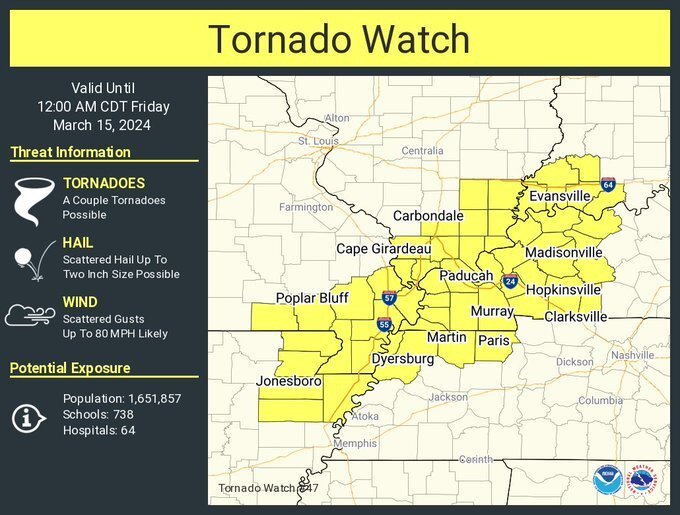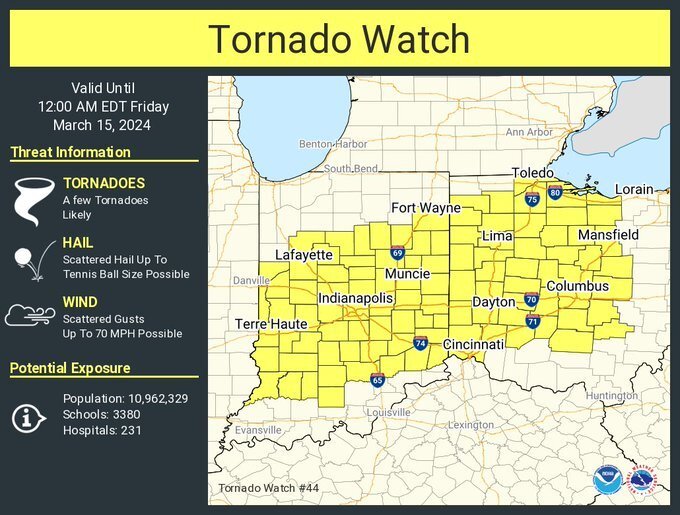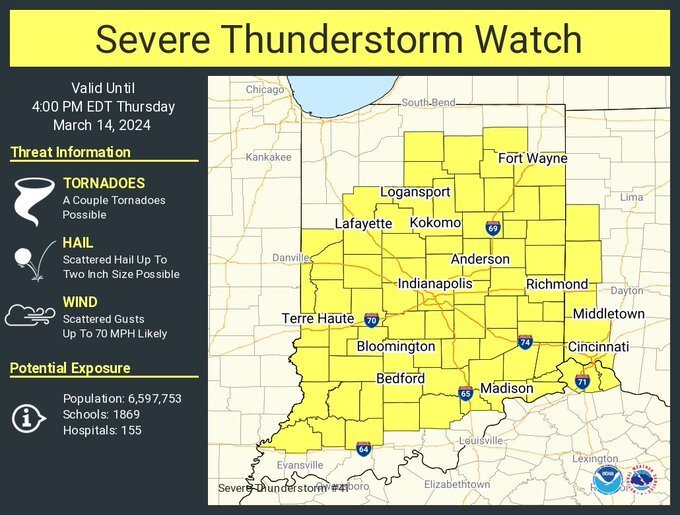-
Posts
25,586 -
Joined
-
Last visited
-
Days Won
2
Everything posted by nWo
-
A wide swath of the region, including parts of the Ohio Valley, the southern Plains, the Ozarks, and a tiny bit of the Mid-Atlantic, is predicted to see severe weather. There is a chance of large to very large hail, powerful tornadoes, and damaging winds. In the southern Plains, the severe threat will peak this afternoon/evening, with the evening/overnight period posing the worst threat to the Ohio Valley region. Supercells from Illinois might cross southern Indiana and possibly southern Ohio in the evening as they move eastward with the warm front. Along this frontal zone, other storms may also form, with huge hail being the main threat. Compared to storms further west, these storms should pose less of an overall threat because to weaker instability and shear. On the other hand, a threat of big hail, destructive wind gusts, and maybe a tornado will be supported by severe shear and moderate instability. A ring of storms is predicted to move in from the west during the course of the night. A serious threat will still be supported by the nocturnal environment. The future evolution of this cluster is still rather unknown. All severe weather threats would be at risk from a cluster of supercells, although a more organized MCS might support a greater severe wind and QLCS (squall line) tornado threat.
-
This afternoon through Tuesday, the area will see periodic showers and thunderstorms brought on by a powerful spring storm system. The majority of the threat from the most widespread severe weather is predicted to occur from after midnight on Monday night through Tuesday afternoon, even if isolated to scattered severe storms are probable tonight evening through Monday, especially in southern Indiana and north central Kentucky. There will be a chance of severe hazards, particularly from late Monday through Tuesday. Make a plan in case of severe weather. Check the latest forecasts. I will post an update early Monday morning.
-
Tuesday update. Everyone should review their emergency action plan as soon as possible. The majority of Kentucky now faces a considerably greater risk of severe weather. The Storm Prediction Center has issued a level 3 Enhanced Risk Area for the majority of Kentucky A severe threat is expected on Tuesday from the Ohio and Tennessee Valleys eastward into the Mid-Atlantic, and southward into the central Gulf Coast states. Wind damage and isolated large hail will be possible across a broad area. The tornado threat is expected to be greatest from central Kentucky east-northeastward into West Virginia. Ohio and Tennessee Valleys/Central Appalachians/Mid-Atlantic... An upper-level trough is forecast to move into the mid- to upper Mississippi Valley on Tuesday, as a cold front advances eastward into the Ohio and Tennessee Valleys. A moist airmass will be in place ahead of the front, with surface dewpoints generally in the 60s F. As instability increases across the warm sector during the day, widespread convective initiation is expected. Numerous thunderstorms are forecast to develop across the Ohio and Tennessee Valleys, with a large MCS (collection of thunderstorms) moving eastward into the central Appalachians by evening. While supercells will be possible, the more favored mode could be multicellular, as several line segments develop and organize during the afternoon. Wind damage will be associated with the faster-moving line segments, while large hail will be most common with rotating cells. Supercells or the more intense QLCS (line of thunderstorms ahead of a cold front) circulations could develop a tornado threat. The greatest tornado threat is forecast to be from eastern Kentucky into West Virginia, where a low-level jet should become focused in the late afternoon and early evening.
-
It now appears we could be in store for a multi-day severe weather event Monday evening into the afternoon on Tuesday. Western Kentucky: the best chance for strong to severe storms arriving Monday evening and overnight ahead of a cold front. Damaging winds and a few spin-up tornadoes look to be the main concerns. Much colder air arrives behind the cold front, with some frost potential Wednesday night and especially Thursday night. Temperatures can also fall below freezing locally, especially near the I-64 corridor. Central/South Central Kentucky: Strong to severe storms are possible late Monday evening through Tuesday afternoon. The best chance for severe storms Monday night will be across southern Indiana, where damaging winds, large hail, spin-up tornadoes, and localized flooding are possible. Confidence in the location and timing of strong storms on Tuesday is lower, but damaging winds, large hail, and tornadoes are all possible.
-
-
The April 3-4, 1974 Super Outbreak is the second largest outbreak of tornadoes on record and holds the record for the most F5 tornadoes on a single day. At least 148 tornadoes developed during the super outbreak, touching down in 13 states, killing around 335 people, and causing approximately $600 million in damages. The first tornado was reported around 9:30 am CDT on April 3 in Indiana, and the final tornado occurred around 8 am CDT on April 4 in North Carolina, with the peak occurring between 2 pm and 10 pm on April 3. Dozens of noteworthy tornadoes occurred in a very short amount of time, making the impact even more severe and the recovery process more daunting. Many of the tornadoes moved at speeds exceeding 50 mph, and two in particular followed identical paths, causing more than half of the recorded deaths from the outbreak and striking many communities twice in under an hour. States across the Midwest experienced colossal loss: Ohio, India, Kentucky, Tennessee, and Alabama had about 200 fatalities and over $80 million in damages between them as a result of the tornadoes, one of which was witnessed by NWS employees. In the aftermath of this catastrophe, it was clear that changes needed to be made, particularly in the areas of public education and awareness. Outside of the NWS, local broadcasters learned they could stay on the air beyond normal operating hours during weather emergencies, and local principalities began to utilize their Emergency Broadcast Systems far more frequently and effectively. NOAA Weather Radio (NWR) proved to be an effective means of disseminating alerts in the larger metropolitan areas during the outbreak, and as a result, NWR was expanded. https://vlab.noaa.gov/web/nws-heritage/-/the-april-1974-super-outbreak-of-tornadoes
-
Valleys of Ohio and Tennessee into the Appalachians... As the upper trough continues, there should be some serious threat over portions of the OH/TN Valleys and into the Appalachians on Tuesday. The precise location of the primary surface low and the evolution of the upper trough remain somewhat uncertain, but there is enough confidence in a somewhat narrow corridor over these regions to add a 15% severe area for Tuesday. A cold front approaching eastward should be preceded by rich, low-level moisture. It appears likely that convection may redevelop and/or intensify by Tuesday afternoon. Given the predicted severity of a low-level jet concentrated over portions of the region, strong deep-layer shear and mild instability should be sufficient for organized severe convection, offering some concern for damaging winds and maybe tornadoes.
-
Thursday's storm was a classic example of a supercell. Look at this 3-D image of the storm, and compare its features to a textbook schematic. It dropped very large hail and produced a long-track EF-2 tornado that crossed the Ohio River three times.
-
-
URGENT - IMMEDIATE BROADCAST REQUESTED Tornado Watch Number 44 NWS Storm Prediction Center Norman OK 415 PM CDT Thu Mar 14 2024 The NWS Storm Prediction Center has issued a * Tornado Watch for portions of much of Indiana western and central Ohio * Effective this Thursday afternoon and evening from 415 PM until 1100 PM CDT. * Primary threats include... A few tornadoes likely Scattered large hail and isolated very large hail events to 2.5 inches in diameter possible Scattered damaging wind gusts to 70 mph possible SUMMARY...Strong/severe thunderstorm development is expected over the next couple of hours across much of Indiana, and spreading into western Ohio thereafter. Along with large hail and locally damaging wind gusts, a few tornadoes will also be possible into this evening. The tornado watch area is approximately along and 65 statute miles north and south of a line from 25 miles north northwest of Terre Haute IN to 35 miles north northeast of Columbus OH. For a complete depiction of the watch see the associated watch outline update (WOUS64 KWNS WOU4). PRECAUTIONARY/PREPAREDNESS ACTIONS... REMEMBER...A Tornado Watch means conditions are favorable for tornadoes and severe thunderstorms in and close to the watch area. Persons in these areas should be on the lookout for threatening weather conditions and listen for later statements and possible warnings.
-
This watch has expired.
-
-
The major danger window for Kentucky will be later this evening and throughout the night. This is illustrated in the lightning flash intensity map below. It covers from 2:00 PM Thursday to 5:00 AM Friday.
-
URGENT - IMMEDIATE BROADCAST REQUESTED Severe Thunderstorm Watch Number 41 NWS Storm Prediction Center Norman OK 1050 AM EDT Thu Mar 14 2024 The NWS Storm Prediction Center has issued a * Severe Thunderstorm Watch for portions of much of Indiana far northern Kentucky parts of western Ohio * Effective this Thursday morning and afternoon from 1050 AM until 400 PM EDT. * Primary threats include... Scattered damaging wind gusts to 70 mph likely Scattered large hail and isolated very large hail events to 2 inches in diameter possible A tornado or two possible SUMMARY...A broken band of thunderstorms is expected to continue intensifying this morning and into this afternoon, as it moves across Indiana and vicinity. Large hail and damaging winds will be possible, along with potential for a couple of brief tornadoes associated with stronger cells within the broader line of storms. The severe thunderstorm watch area is approximately along and 70 statute miles east and west of a line from 60 miles north northwest of Muncie IN to 50 miles south of Bloomington IN. For a complete depiction of the watch see the associated watch outline update (WOUS64 KWNS WOU1). PRECAUTIONARY/PREPAREDNESS ACTIONS... REMEMBER...A Severe Thunderstorm Watch means conditions are favorable for severe thunderstorms in and close to the watch area. Persons in these areas should be on the lookout for threatening weather conditions and listen for later statements and possible warnings. Severe thunderstorms can and occasionally do produce tornadoes.
-
Since this morning, there is a greater chance of severe weather. The level 2 Slight Risk area has been extended by the Storm Prediction Center to about the I-65 corridor. Additionally, the Cincinnati/NKY region is included by extending it along the Ohio River. Thunderstorm bands are still lingering over parts of Illinois and Missouri. As it moves quickly east-northeastward this morning, this activity could continue to present isolated chances for one or more embedded tornadoes as well as intermittent severe gusts. Threats from severe gusts and tornadoes can concentrate along the warm front. However, the early-morning instability minimum in the boundary layer may potentially mitigate the catastrophic danger locally. In certain areas of IN and possibly KY, the combined complex may be re-intensifying to some extent at this time. An additional possible round of convection this afternoon and tonight appears to pose a conditionally serious threat for tornadoes, big to very large hail, and severe wind. Long-lasting supercells and bending clusters may develop in areas of the atmosphere that are not disturbed by outside influences.
-
-
Western Kentucky: Isolated to scattered severe storms are possible, with slightly higher chances across southeast Missouri and southwest Illinois. Stay aware of the latest updates. For now, the timing is after 3 pm Thursday through the early overnight hours. Primary Hazards: Quarter-size hail (1” Diameter), Damaging wind gusts to 60 mph Isolated tornadoes are possible The exact timing of the frontal boundary and associated line of thunderstorms is still uncertain, as is the eastward extent of the severe threat into Kentucky and southwest Indiana. Rest of Kentucky: Widespread rain and thunderstorms are possible Thursday night into Friday morning. Embedded strong to severe storms may be possible during this timeframe. Damaging wind gusts, hail, and an isolated tornado are all possible hazards.
-
For some areas of western Kentucky, the serious threat has intensified. There is a chance that the activity, which was first over the Mid Mississippi Valley, will eventually move from elevated to surface-based—or at least near-surface-based—as it interacts with the warm front moving northward across the area. There may be a chance of an isolated tornado as well as updraft organization under certain circumstances. Stronger storms or thunderstorm clusters may also produce huge hail and damaging gusts.
-
On Thursday, there may be some strong to severe storms over parts of western Kentucky.There is a chance that the activity that was first over the Mid MS Valley will interact with the warm front moving northward across the area, moving from high to surface-based—or at least near-surface-based—as it goes eastward. Forecast confidence is limited by uncertainties about the front's position and the way convection moves out of the Mid-MS Valley. Nevertheless, upcoming data will be carefully examined, and upgrades might be taken into account in upcoming outlooks.
.png.ffa34568722b20f38e3c3ecfcb9a2cd2.png)

.thumb.jpg.d475a671bdc851f901dea439c04b8f9d.jpg)




















































